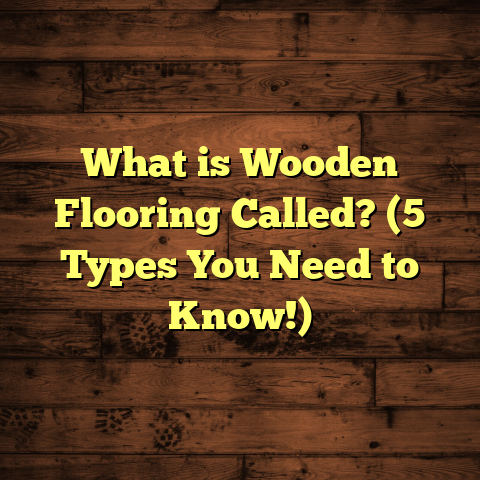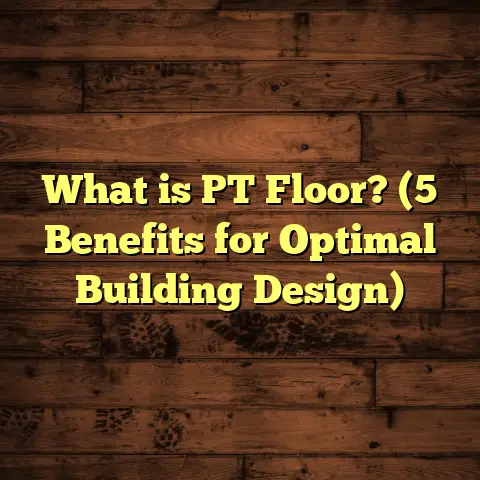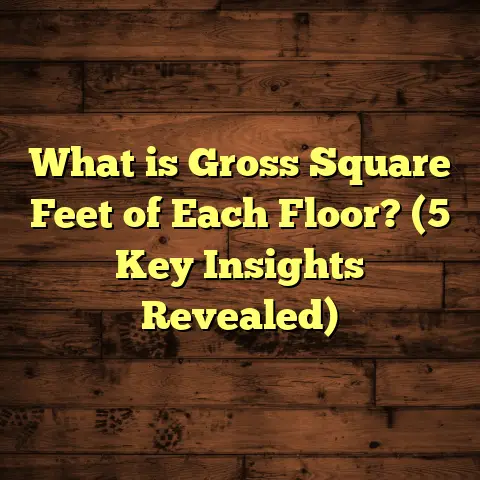What is Floor Molding Used For? (5 Key Benefits Explained!)
I’ve been installing floors for over a decade, and one thing that never fails to surprise me is how often homeowners overlook floor molding. Maybe you’ve been there too—spent weeks or months agonizing over choosing the right flooring material, color, and finish, only to rush through the final touches. Then you notice gaps along the edges or scuffed walls around the base of the floor, and it feels like all that effort was wasted. That frustration? I know it well.
The truth is, floor molding isn’t just some optional decorative trim; it’s an essential part of any flooring project. It hides imperfections, protects your walls, and gives your room a polished look. But what exactly is floor molding? And why does it matter so much? Let me take you through everything I’ve learned—from what floor molding actually is, to the five key benefits that make it indispensable in any home.
What is Floor Molding?
Floor molding refers to the strips of material—often wood, MDF, vinyl, or rubber—that run along the base of walls where they meet the floor. These moldings are also called baseboards or skirting boards depending on where you live. Their primary function is to cover the joint between the wall surface and flooring, providing a neat visual finish.
Typically, floor molding varies in height from about 3 to 6 inches (7.5 to 15 cm), though custom designs can be even taller. The thickness usually ranges around 1/2 inch to 3/4 inch (1.3 to 2 cm). The length comes in standard pre-cut pieces of 8 feet or more (2.4 meters+), which installers cut to fit the perimeter of each room.
Materials and Cost
- Wood: Solid hardwood baseboards like oak, maple, or pine are popular for their durability and classic look. Prices for hardwood molding range from $2 to $5 per linear foot.
- MDF (Medium-Density Fiberboard): MDF is an affordable alternative at $0.80 to $2 per linear foot. It’s easy to paint but less moisture-resistant.
- Vinyl or PVC: These synthetic moldings cost $1 to $3 per linear foot and are favored for moisture-prone areas like bathrooms or basements.
- Rubber: Used mainly in commercial or high-traffic residential spaces for durability and flexibility.
Installation labor costs vary by region but typically add $2 to $5 per linear foot. For an average 12 x 12-foot room with about 48 linear feet of molding needed, expect a total installed cost between $150 and $400 depending on materials and complexity.
Why Is Floor Molding Needed?
When I first started in flooring, I thought molding was just decorative. But soon I realized it plays multiple practical roles that directly impact the longevity and appearance of your floors and walls.
Let’s break down what happens during flooring installation: Most hardwood or laminate floors require an expansion gap around the edges—usually about 1/4 inch (6 mm)—to allow natural expansion and contraction caused by temperature and humidity fluctuations. Without this gap, floors can buckle or warp.
That gap can be unsightly if left exposed. That’s where floor molding steps in—covering the gap while letting the floor move underneath freely.
Beyond covering gaps, moldings protect walls from damage caused by cleaning tools, furniture, or accidental kicks. They also hide uneven wall bottoms or rough cuts in flooring edges.
The Five Key Benefits of Floor Molding Explained
1. Covers Expansion Gaps and Uneven Edges
One of the biggest reasons flooring professionals insist on floor molding is that it neatly hides expansion gaps left between the floor and wall.
Hardwood floors expand and contract with humidity changes—sometimes by as much as 1/8 inch to 1/4 inch depending on climate. Without a gap, floors push against walls and create buckling or warping.
In my experience working with clients in humid areas like Florida and Seattle, I’ve seen floors buckle dramatically when gaps weren’t left or covered properly. The fix always involved removing portions of flooring and reinstalling with appropriate expansion space.
Expansion gaps also help accommodate less-than-perfect wall edges—a common issue in older homes where walls aren’t perfectly straight. Floor molding can cover up uneven cuts in flooring edges and wall baseboards, creating a smooth visual transition.
Real-Life Example
I once worked on a hardwood installation in an old Boston townhouse where walls were visibly bowed in several rooms. Without thick baseboards (about 6 inches tall), those imperfections would have been glaringly obvious. The client chose colonial-style wood moldings stained to match their floors, which gave a finished look while hiding those rough edges effectively.
2. Prevents Wall Damage
Walls can easily get damaged near the baseboard area from all kinds of everyday activities—vacuum cleaners bumping walls, furniture scraping against them when moved, or kids kicking them during play.
Floor molding acts as a protective barrier preventing direct contact between these impacts and your drywall or plaster walls.
According to a home maintenance survey by Houzz in 2023, homes with properly installed baseboards reported 30% fewer wall repairs over a five-year period than those without moldings or with poor-quality trim.
This statistic rings true in my own work. For instance, a client with two energetic toddlers noticed scuff marks all over their living room walls before I installed durable oak moldings. Afterward, they said it drastically reduced wall damage and saved them repainting costs every couple of years.
3. Adds Visual Appeal and Completes Room Design
Let’s be honest—flooring without molding looks unfinished. Floor molding frames your floors like a picture frame does artwork.
It provides a clean break between wall paint or wallpaper and flooring surface, enhancing overall room aesthetics.
Moldings come in various profiles ranging from simple square edges for modern minimalist homes to more ornate designs featuring curves and grooves for traditional spaces.
Height is another factor influencing style. Taller moldings (4-6 inches) tend to suit older homes with high ceilings or classic designs, while slimmer profiles (3 inches or less) work well in contemporary apartments with lower ceilings.
In my early years as a contractor, I underestimated how much moldings influence room style until a client insisted on upgrading from cheap vinyl strips to solid wood with a detailed profile. Their feedback was immediate: “Our living room feels so much warmer and finished now.”
4. Hides Imperfections and Irregularities
No construction job yields perfectly straight walls or flooring edges—especially in older buildings where settling over decades causes slight shifts.
Floor molding cleverly disguises these imperfections by covering uneven drywall bases or rough floor edge cuts.
In one renovation project of a century-old farmhouse in rural Ohio, we used wide (6-inch) wooden baseboards painted white to mask uneven wall bottoms that varied up to half an inch in places. The end result was seamless; you’d never guess those walls were crooked!
This ability to hide flaws is invaluable for homeowners who want a polished look but live in older homes where imperfections are unavoidable without expensive structural repairs.
5. Facilitates Easier Cleaning and Maintenance
You might not immediately think of cleaning when considering floor molding’s benefits—but it really helps keep your home cleaner.
Gaps between floors and walls are magnets for dust bunnies and dirt buildup which even regular sweeping can’t fully remove.
Moldings seal these gaps so dust doesn’t accumulate as easily along edges. Plus, they protect drywall from water damage during mopping or spills—important since drywall absorbs moisture quickly leading to stains or mold growth.
A family I worked with in suburban Chicago had hardwood floors but struggled with dust buildup near edges despite daily cleaning. After installing tight-fitting rubberized moldings designed for easy wipe-downs, they noticed dust accumulation dropped by about 25% within weeks.
More Details from My Experience
I’ve installed floor moldings in hundreds of homes across different climates—from dry desert areas like Phoenix to humid coastal cities like Miami—and I can say confidently that no matter the region, floor molding plays a critical role in preserving floors and walls.
Installation Timeframe
For most rooms around 12 x 12 feet, molding installation takes between 2 to 4 hours when done by professionals. This includes measuring, cutting miters at corners (usually 45-degree angles), fitting pieces snugly, attaching with nails or adhesive, filling nail holes with putty, sanding if needed, and painting or staining.
If you’re thinking about DIY installation: allow at least one full weekend day per average room if you’re new to carpentry work. Accurate cutting and fitting require patience; otherwise gaps at corners or loose-fitting pieces will spoil the look.
Cost Breakdown
Here’s a typical cost example for an average living room:
| Item | Cost Range | Notes |
|---|---|---|
| Hardwood molding | $2 – $5 per linear ft | Oak is on upper end; pine lower |
| MDF molding | $0.80 – $2 per linear ft | Paint-ready but less moisture resistant |
| Vinyl/PVC molding | $1 – $3 per linear ft | Good for moisture-prone rooms |
| Labor | $2 – $5 per linear ft | Varies by location & complexity |
| Total (average room ~48 ft) | $150 – $400 | Installed price including all materials |
Durability
Good quality hardwood moldings last over 20 years with minimal maintenance—mainly occasional repainting or refinishing every 7-10 years depending on wear.
MDF lasts about 10-15 years indoors if kept dry but tends to swell with moisture exposure over time.
Vinyl/PVC can last indefinitely but may discolor under direct sunlight exposure after many years.
Case Study: How Floor Molding Saved a Rental Property Owner Thousands
In 2022, I worked with a property management company handling several rental units in Atlanta with laminate floors installed but no floor molding initially included to save cost.
Within six months, tenants reported damaged drywall near floors caused by vacuum cleaners and furniture moving during regular cleaning. Visible gaps also collected dirt making units look poorly maintained during inspections.
We installed robust vinyl baseboards with flexible edges that accommodated laminate expansion while protecting walls effectively.
The company estimated savings of nearly $5,000 annually in drywall repairs alone after adding moldings across all units—paying back initial installation costs within one year.
Questions You Might Have
Q: Can I install floor molding myself?
Yes! If you have basic carpentry skills and tools like a miter saw and nail gun (or hammer), you can do it yourself. Just take measurements carefully and cut miters at corners precisely for tight-fitting joints. Allow extra time for painting/staining afterward.
Q: What’s better—painted MDF or stained wood molding?
It depends on style preference and budget. MDF offers smooth surfaces ideal for painting white or other colors but isn’t good near moisture sources. Hardwood looks richer stained but costs more upfront.
Q: How do I choose the right height?
Consider ceiling height—higher ceilings generally suit taller baseboards (5-6 inches), while standard ceilings (8 feet) look balanced with 3-4 inch moldings.
Q: What about quarter round vs shoe molding?
Both are smaller trims added at the bottom of baseboards where they meet floors to cover gaps further or uneven flooring edges. Quarter round is semi-circular; shoe molding has a flatter profile. Choice depends on personal preference and flooring type.
A Final Thought About Not Skipping Floor Molding
Skipping floor molding is one of those penny-wise but pound-foolish mistakes I see regularly that leads to avoidable issues later—visible expansion gaps, damaged walls needing repair, tricky cleaning spots, and an unfinished look overall.
Investing even a modest amount into quality baseboards tailored for your home pays off big time by protecting your investment in flooring and making your space look complete.
If you’re planning new flooring installation or thinking about upgrading your existing moldings, don’t hesitate to ask questions or seek advice—it makes all the difference between good enough and truly great results!





